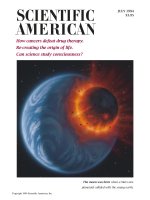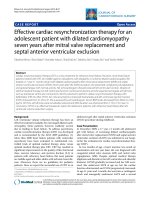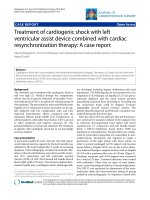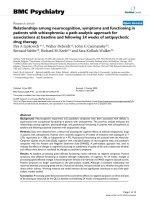Cardiac drug therapy humana press (2015)
Bạn đang xem bản rút gọn của tài liệu. Xem và tải ngay bản đầy đủ của tài liệu tại đây (13.98 MB, 806 trang )
Contemporary Cardiology
Series Editor: Christopher P. Cannon
M. Gabriel Khan
Cardiac
Drug Therapy
8th Edition
CONTEMPORARY CARDIOLOGY
CHRISTOPHER P. CANNON, MD
SERIES EDITOR
More information about this series at
/>
M. Gabriel Khan
Cardiac Drug
Therapy
8th Edition
M. Gabriel Khan, MD, FRCPC, FRCP (London), FACC
University of Ottawa
The Ottawa Hospital
Ottawa, ON, Canada
ISSN 2196-8969
ISSN 2196-8977 (electronic)
ISBN 978-1-61779-961-7
ISBN 978-1-61779-962-4 (eBook)
DOI 10.1007/978-1-61779-962-4
Springer Totowa Heidelberg New York Dordrecht London
Library of Congress Control Number: 2014952818
© Springer Science+Business Media New York 2015
This work is subject to copyright. All rights are reserved by the Publisher, whether the
whole or part of the material is concerned, specifically the rights of translation,
reprinting, reuse of illustrations, recitation, broadcasting, reproduction on microfilms or
in any other physical way, and transmission or information storage and retrieval,
electronic adaptation, computer software, or by similar or dissimilar methodology now
known or hereafter developed. Exempted from this legal reservation are brief excerpts
in connection with reviews or scholarly analysis or material supplied specifically for the
purpose of being entered and executed on a computer system, for exclusive use by the
purchaser of the work. Duplication of this publication or parts thereof is permitted only
under the provisions of the Copyright Law of the Publisher’s location, in its current
version, and permission for use must always be obtained from Springer. Permissions for
use may be obtained through RightsLink at the Copyright Clearance Center. Violations
are liable to prosecution under the respective Copyright Law.
The use of general descriptive names, registered names, trademarks, service marks, etc.
in this publication does not imply, even in the absence of a specific statement, that such
names are exempt from the relevant protective laws and regulations and therefore free
for general use.
While the advice and information in this book are believed to be true and accurate at the
date of publication, neither the authors nor the editors nor the publisher can accept any
legal responsibility for any errors or omissions that may be made. The publisher makes
no warranty, express or implied, with respect to the material contained herein.
Printed on acid-free paper
Humana Press is a brand of Springer
Springer is part of Springer Science+Business Media (www.springer.com)
To My wife Brigid
and to our
Children
Susan, Christine, Yasmin,
Jacqueline, Stephen,
and Natasha
And to our
Grandchildren
Sarah, Patrick, Emma,
Kathleen, Michael, Roxanna,
Fiona, Jaxson, James, Fraea,
Esmé, Jordan, and Joshua
Preface
Several foreign translations and favorable reviews of earlier editions provided the impetus to produce an eighth edition of Cardiac Drug Therapy. Here is a review of the fifth
edition in Clinical Cardiology: “this is an excellent book. It
succeeds in being practical while presenting the major evidence in relation to its recommendations. Of value to absolutely anyone who prescribes for cardiac patients on the
day-to-day basis. From the trainee to the experienced consultant, all will find it useful. The author stamps his authority very clearly throughout the text by very clear assertions
of his own recommendations even when these recommendations are at odds with those of official bodies. In such situations the ‘official’ recommendations are also stated but
clearly are not preferred.”
And for the fourth edition a cardiologist reviewer states
that it is “by far the best handbook on cardiovascular therapeutics I have ever had the pleasure of reading. The information given in each chapter is up-to-date, accurate, clearly
written, eminently readable and well referenced.”
The entire text has been revised and, most importantly, continues to give practical clinical advice. New chapters include:
• Endocrine Heart Diseases
• Management of Cardiomyopathies
• Newer Agents
vii
viii
Preface
A new feature involves diagnosis.
• Because appropriate therapy requires sound diagnosis the
short sections on diagnosis given in previous editions have
been expanded.
Other highlights include:
• Chapter 11: “Acute Myocardial Infarction” contains more
than 24 relevant ECG tracings; an echocardiogram depicting
Takotsubo syndrome is shown to remind readers that this
syndrome mimics acute MI.
• Chapter 14: “Management of Cardiac Arrhythmias” provides more than 24 ECG samples.
• Chapter 22: “Hallmark Clinical Trials” has been expanded
to accommodate the wealth of practical information derived
from recent randomized clinical trials.
As in all previous editions, therapeutic strategies and
advice are based on a thorough review of the scientific literature, applied logically:
• Scientific documentation regarding which drugs are
superior.
• Information on which cardiovascular drugs to choose and
which agents to avoid in various clinical situations.
• Information that assists with the rapid writing of prescriptions. To write a prescription accurately, a practitioner needs
to know how a drug is supplied and its dosage. Thus, supply
and dosage are given first, followed by action and pharmacokinetics, and then advice as to efficacy and comparison
with other drugs, indications, adverse effects, and
interactions.
The text contains practical advice, such as the following:
The life-saving potential of 160–240 mg chewable aspirin is
denied to many individuals who succumb to an acute coronary syndrome because of poor dissemination of clinically
proven, documented facts. The text advises: three ~80 mg
chewable aspirins should be placed in the cap of a nitrolin-
Preface
ix
gual spray container to be used before proceeding to an
emergency room. Clinicians should inform patients that
rapidly acting chewable aspirin may prevent a heart attack
or death but that nitroglycerin does not. The world faces an
epidemic of heart failure [HF].
Although medical therapy for acute HF has improved
dramatically from 1990, unfortunately more than 50 % of
patients require readmission within 6 months of discharge.
Several of these patients are not administered appropriate
medications to prevent a recurrence. The chapter on heart
failure gives practical advice as do other chapters on what
drugs are best for a given situation.
Notable physicians have stated that the beta-blockers
should not be prescribed for primary hypertension because of
their ineffectiveness. Many investigators have reported in
peer-reviewed journals that diuretics and beta-blockers cause
diabetes and their use should be restricted for the management of hypertension. Chapter 2 discusses these controversies and gives clear answers to clinicians worldwide.
The information provided in the eighth edition should
serve as a refresher for cardiologists and internists. The
information should improve the therapeutic skills of interns,
medical residents, generalists, and all who care for patients
with cardiac problems.
Ottawa, ON
M. Gabriel Khan
Acknowledgment
I have quoted the published works of several investigators. These persevering women and men of medicine
deserve my respect and my thanks.
A special, thank you, to my wife Brigid, who has allowed
me to be a student of the science of Medicine to this day.
Ottawa, ON
M. Gabriel Khan
xi
Contents
1
Beta-Blockers: The Cornerstone
of Cardiac Drug Therapy.................................
This chapter tells you ........................................
Beta-Blockers and Cardioprotection ..............
Beta-Receptors ..................................................
Mechanism of Action ........................................
Other Important Clinically Beneficial
Mechanisms ....................................................
Beta-Blocker Effect on Calcium
Availability ......................................................
Dosage Considerations .....................................
Pharmacologic Properties and Clinical
Implications ........................................................
Cardioselectivity.............................................
Intrinsic Sympathomimetic Activity ............
Membrane-Stabilizing Activity ....................
Effects on Renin ............................................
Lipid Solubility ...............................................
Plasma Volume ...............................................
Hepatic Metabolism ......................................
Effects on Blood and Arteries .....................
Effect on Serum Potassium...........................
Salutary Effects of Beta-Adrenergic
Blockade .............................................................
xiii
1
1
2
6
9
10
10
11
14
14
18
19
19
20
20
21
21
22
23
xiv
Contents
Beta-Blockers Versus Calcium Antagonists
and Oral Nitrates ...............................................
Indications for Beta-Blockers ..........................
Angina .............................................................
Arrhythmias ....................................................
Acute Myocardial Infarction ........................
Elective Percutaneous Coronary
Intervention (PCI) .........................................
Heart Failure ..................................................
Prolonged QT Interval Syndromes .............
Dissecting Aneurysm .....................................
Mitral Valve Prolapse ....................................
Mitral Regurgitation and Mitral Stenosis ...
Tetralogy of Fallot ..........................................
Hypertrophic Cardiomyopathy ....................
Marfan’s Syndrome .......................................
Subarachnoid Hemorrhage...........................
Perioperative Mortality .................................
Neurocardiogenic Syncope (Vasovagal/
Vasodepressor Syncope) ...............................
Diabetic Patients ............................................
Chronic Obstructive Pulmonary Disease ...
Noncardiac Indications .................................
Advice and Adverse Effects.............................
Warnings..........................................................
Side Effects .....................................................
Individual Beta-Blockers ..................................
Dosage (Further Advice) ..............................
Action ..............................................................
Indications.......................................................
Dosage (Further Advice) ..............................
Action ..............................................................
Indications.......................................................
Dosage (Further Advice) ..............................
Indications.......................................................
Indications.......................................................
Contraindications ...........................................
24
26
26
26
29
29
31
33
33
34
34
34
34
35
36
36
38
39
39
41
41
41
43
44
47
48
48
49
50
50
52
56
57
58
Contents
Which Beta-Blocker Is Best
for Your Patients? ..............................................
References ..........................................................
2
3
Beta-Blocker Controversies .............................
Beta-Blockers Are not a Good Initial
Choice for Hypertension: True or False? ........
Beta-Blockers Are not Recommended
for Treatment of Elderly Hypertensives:
True or False? .....................................................
Beta-Blockers Cause Genuine Diabetes
Mellitus: True or False?. ....................................
Do all Beta-Blockers Cause Benign
Glucose Intolerance? ........................................
Beta-Blockers Should not Be Given
to Patients During the Early Hours
of Acute Mi: True or False? ..............................
References ..........................................................
Angiotensin-Converting Enzyme
Inhibitors and Angiotensin II Receptor
Blockers ..............................................................
Mechanism of Action ........................................
ACE Inhibitors Versus Other Vasodilators ....
Clinical Indications ............................................
Hypertension ..................................................
Heart Failure ..................................................
Acute Myocardial Infarction ........................
Renoprotection ..............................................
Coarctation of the Aorta...............................
Pulmonary Hypertension ..............................
Scleroderma Renal Crisis .............................
Bartter’s Syndrome ........................................
ACE Inhibitors/ARBs and Diabetes...........
Contraindications ..............................................
Advice, Adverse Effects, and Interactions .....
Hypotension ...................................................
Renal Failure ..................................................
xv
58
61
69
69
73
74
78
79
80
85
86
93
94
94
97
100
101
104
105
105
105
105
106
107
107
107
xvi
4
Contents
Hyperkalemia .................................................
Cough ..............................................................
Loss of Taste Sensation .................................
Angioedema ...................................................
Rash .................................................................
Proteinuria ......................................................
Neutropenia and Agranulocytosis ...............
Mild Dyspnea and/or Wheeze ......................
Anaphylactoid Reactions ..............................
Uncommon Adverse Effects ........................
Interactions .....................................................
Individual ACE Inhibitors ................................
Pharmacologic Profile and Individual
Differences ......................................................
Subtle Differences .........................................
Hypotension ...................................................
Dosage (Further Advice) ..............................
Pharmacokinetics ...........................................
Dosage (Further Advice) ..............................
Pharmacokinetics ...........................................
Dosage (Further Advice) ..............................
Pharmacokinetics ...........................................
Dosage (Further Advice) ..............................
Angiotensin II Receptor Blockers ..................
Clinical Trials ..................................................
References ..........................................................
107
107
108
108
109
109
109
109
109
110
110
110
ACE Inhibitor ARB Controversies.................
ACE Inhibitors Versus ARBs:
Does the Choice Matter? .................................
ACE Inhibitors/ARBs Cause
Renoprotection: True or False?........................
ACE Inhibitors Decrease the Incidence
of Diabetes: True or False? ...............................
Combination of ACE Inhibitor and ARB
Proven Effective: True or False? ......................
References ..........................................................
129
110
110
111
112
112
113
114
115
115
116
119
120
124
129
132
134
135
136
Contents
5
6
7
Calcium Antagonists
(Calcium Channel Blockers) ............................
Mechanism of Action ........................................
Action ..............................................................
Adverse Effects and Interactions
for DHPs .........................................................
Action ..............................................................
Adverse Effects and Interactions ................
Action ..............................................................
Advice, Adverse Effects, and Interactions ....
Dosage (Further Advice) ..............................
Indications for Calcium Antagonists...............
Hypertension ..................................................
Stable Angina .................................................
References ..........................................................
xvii
139
140
143
144
147
147
149
150
153
153
153
154
158
Calcium Antagonist Controversies..................
Calcium Antagonists Cause an Increased
Incidence of HF and MI: True or False? .........
Newer Calcium Antagonists Are Better
Than Older Agents: True or False? .................
Are Calcium Antagonists Safe
for Hypertensives with CAD? .........................
INVEST ..........................................................
CONVINCE ...................................................
References ..........................................................
161
Diuretics..............................................................
Indications ..........................................................
Hypertension ..................................................
Heart Failure ..................................................
Thiazides .............................................................
Loop Diuretics ...................................................
Mechanism of Action ....................................
Dosage (Further Advice) ..............................
Action and Pharmacokinetics ......................
Potassium-Sparing Diuretics ............................
167
170
170
171
172
174
174
175
175
179
161
162
163
163
164
166
xviii
8
Contents
Advantages .....................................................
Disadvantages.................................................
Combination of a Thiazide
or Furosemide and Potassium-Sparing
Diuretic ...........................................................
Other Diuretics ..................................................
Potassium Chloride Supplements ....................
Potassium Chloride ........................................
Salt Substitutes ...............................................
Further Advice ...................................................
Torsemide........................................................
Aldosterone Antagonists ..............................
References ..........................................................
182
183
Hypertension ......................................................
Relevant Key Issues ..........................................
Controversies .....................................................
Definitions ..........................................................
Isolated Systolic Hypertension
in Older Patients ............................................
Pseudohypertension.......................................
Home Measurements ....................................
Nondrug Therapy...............................................
Which Drugs to Choose....................................
Recommendations for Patients
Without Coexisting Disease .........................
Therapy for Patients with Coexisting
Diseases ...........................................................
Beta-Blockers.....................................................
Dosage .............................................................
Action of Beta-Blockers ...............................
Diuretics..............................................................
Action ..............................................................
Use Proven in Elderly ...................................
Chlorthalidone ...............................................
ACE Inhibitors and Angiotensin II
Receptor Blockers .............................................
199
199
205
206
185
186
187
190
190
192
192
192
195
206
207
208
208
209
210
220
223
223
224
227
227
229
231
234
Contents
Adverse Effects and Interactions ................
Contraindications ...........................................
Dosage (Further Advice) ..............................
ACE Inhibitor-Diuretic Combination .........
Calcium Antagonists .........................................
Alpha1-Blockers ................................................
Centrally Acting Drugs .....................................
Resistant Hypertension ....................................
Cathetehr-Based Radiofrequency Renal
Denervation........................................................
Hypertensive Crisis ...........................................
Action and Metabolism.................................
Advice, Adverse Effects, and Interactions ....
References ..........................................................
9
10
xix
236
237
238
239
240
243
244
244
246
247
250
250
253
Hypertension Controversies.............................
Beta-Blockers Should Not Remain First
Choice in the Treatment of Primary
Hypertension: True or False? ...........................
Conclusion ......................................................
Diabetic Risk with Beta-Blockers
and Diuretics ......................................................
An Increased Risk: True or False? ...............
Hypertensive Agents Increase Heart
Failure Risk: True or False? ..............................
Age and Ethnicity Hold the Key
for Drug Choice .................................................
References ..........................................................
261
Angina.................................................................
Salient Clinical Features ...................................
Pathophysiologic Implications .....................
Treatment of Stable Angina .............................
Beta-Adrenoceptor Blocking Agents..........
Cardioprotection and Dosage
of Beta-Blocker ..............................................
Contraindications to Beta-Blockers ............
283
283
284
285
286
261
268
269
269
271
272
278
290
290
xx
Contents
Combination of Beta-Blockers
and Calcium Antagonists ..............................
Nitrates ............................................................
Cutaneous Nitroglycerins .............................
Cutaneous Nitrates ........................................
Indications.......................................................
Aspirin .............................................................
Ranolazine ......................................................
Consider Interventional Therapy ....................
Management of Unstable Angina ...................
Investigations ..................................................
Medications.....................................................
Statins ..................................................................
Variant Angina (Prinzmetal’s) .........................
References ..........................................................
11
Myocardial Infarction .......................................
Overview.............................................................
TRIGGERS for ACS ....................................
DIAGNOSIS ......................................................
Electrocardiographic Features .........................
Inferior MI Diagnosis ....................................
Anterior MI Diagnosis ..................................
ECG Mimics of Acute Myocardial
Infarction.........................................................
Therapy ...............................................................
Pain Relief ......................................................
Percutaneous Coronary Intervention .............
Clopidogrel .....................................................
Prasugrel .........................................................
Ticagrelor (BRILINTA; Brilique in UK) .....
Thrombolytic Therapy.......................................
The incidence of ICH in RCTs
was reported as follows .................................
Contraindications ...........................................
292
292
293
295
298
299
301
303
303
303
304
306
306
307
311
311
313
314
317
317
317
320
330
332
334
335
335
336
339
341
341
Contents
Streptokinase [Kabikinase, Streptase].........
Tenecteplase ...................................................
Enoxaparin .........................................................
Fondaparinux .....................................................
Beta-Blockers.....................................................
ACE Inhibitors ..................................................
NITRATES ........................................................
STATINS ............................................................
Management of Complications
of Infarction........................................................
Arrhythmias ....................................................
Heart Failure ..................................................
Right Ventricular Infarction .........................
Cardiogenic Shock .........................................
Management ...................................................
Early Reperfusion ..........................................
Management of Non-ST-Elevation
Myocardial Infarction .......................................
Conservative Generally Preferred
[angiogram 24–36 h] ......................................
Medications on Discharge ................................
References ..........................................................
12
Heart Failure ......................................................
The Size of the Problem ...................................
Causes of Heart Failure ....................................
Basic Cause .....................................................
Diagnosis ............................................................
Pathophysiology.................................................
Management Guide .......................................
Vasodilators ........................................................
ACE Inhibitors/Angiotensin II
Receptor Blockers .........................................
Angiotensin-Receptor Blockers...................
Transcend (2008)................................................
xxi
342
343
343
344
345
348
349
350
350
350
353
354
354
355
356
357
360
360
361
369
369
372
372
376
379
381
382
382
387
388
xxii
13
Contents
Hydralazine ........................................................
Calcium Antagonists .........................................
Amlodipine .....................................................
Diuretics..............................................................
Indications and Guidelines ...........................
Aldosterone Antagonists ..................................
Beta-Blockers.....................................................
Inotropic Agents ................................................
Digoxin Studies ..............................................
Dosage Considerations .................................
Symptoms of Toxicity ....................................
Beta-Stimulants ..............................................
New Developments ...........................................
Spironolactone ...............................................
Istaroxime .......................................................
Omecamtiv mecarbil .....................................
SERCA2a........................................................
Serelaxin ..........................................................
Rosuvastatin ...................................................
LCZ696 ...........................................................
Management of Pulmonary Edema ................
References ..........................................................
389
389
389
389
389
390
393
399
399
405
409
412
413
413
413
414
413
414
415
415
415
417
Heart Failure Controversies .............................
Are ARBs as Effective as ACE Inhibitor
Therapy for Heart Failure? ..............................
Management of Heart Failure Preserved
Ejection Fraction ...............................................
Treatment............................................................
Digoxin Is Not Useful for HFPEF:
True or False? .....................................................
Is CHARM-Preserved a Clear Study
of HFPEF? ......................................................
Does an ACE Inhibitor Combined
with an ARB Improve Outcomes?..................
Heart Failure in Blacks:
Do Differences Exist? .......................................
423
423
424
426
427
427
428
429
Contents
xxiii
Are Statins Recommended
for Patients with Heart Failure? ...................... 429
References .......................................................... 430
14
Arrhythmias .......................................................
Classification ......................................................
Diagnosis of Arrhythmias.................................
Arrhythmias with Narrow QRS
Complex ..........................................................
Arrhythmias with Wide QRS
Complex ..........................................................
Management of Supraventricular
Arrhythmias .......................................................
AV Nodal Reentrant Tachycardia ...............
Multifocal Atrial Tachycardia
(Chaotic Atrial Tachycardia) ........................
Paroxysmal Atrial Tachycardia
with Block .......................................................
Atrial Premature Contractions ....................
Atrial Flutter ..................................................
Atrial Fibrillation ...........................................
Chronic Atrial Fibrillation ................................
Atrial Fibrillation Post Surgery ....................
Synchronized DC Cardioversion .................
Rate Control Versus Rhythm Control ........
Anticoagulants for AF ......................................
Newer Anticoagulants.......................................
Genetically Mediated Arrhythmic
Disorders ............................................................
Wolff–Parkinson–White Syndrome .............
Ventricular Arrhythmias ...................................
Premature Ventricular Contractions:
Benign Arrhythmias ......................................
Ventricular Tachycardia ....................................
Fatal Ventricular Arrhythmias ......................
Antiarrhythmic Agents .....................................
433
434
435
437
437
454
454
459
459
460
460
462
465
466
466
467
469
470
472
472
477
477
478
478
481
xxiv
15
16
Contents
Class IA ...........................................................
Advice, Adverse Effects, and Interactions .....
Class IB ...........................................................
Class IC ...........................................................
Class II.............................................................
Class III ...........................................................
Adverse Effects ..............................................
References ..........................................................
481
483
486
488
490
492
494
496
Cardiac Arrest ....................................................
“Time Is of the Essence” ..................................
Two Cardiac Rhythms .......................................
Basic Life Support .............................................
Defibrillation ..................................................
Drug Therapy .....................................................
Asystole and Pulseless Idioventricular
Rhythms ..........................................................
Isoproterenol Is Contraindicated
in the Treatment of Cardiac Arrest .............
Beta-Blockers .................................................
References ..........................................................
503
503
505
507
510
512
Infective Endocarditis .......................................
Classification and Diagnosis ............................
Diagnostic Guidelines ...................................
Therapy ...............................................................
S. aureus Endocarditis ...................................
Prosthetic Valve Endocarditis ......................
Native Valve Endocarditis Caused by
Staphylococci ..................................................
Native Valve Endocarditis ............................
Prosthetic Valve Endocarditis Caused
by Susceptible S. viridans or S. bovis
Infections.........................................................
Other Bacteria Causing IE ...........................
Right-Sided Endocarditis ..............................
Fungal Endocarditis.......................................
517
518
518
522
523
525
514
514
514
514
525
525
526
528
528
530









